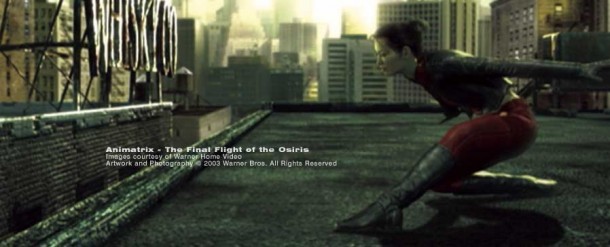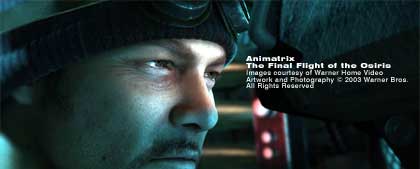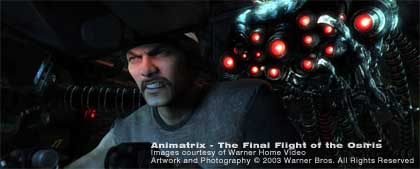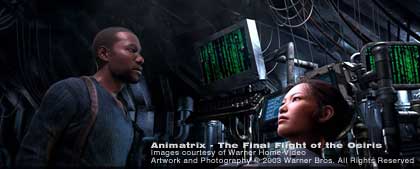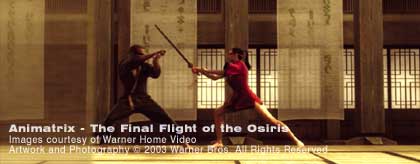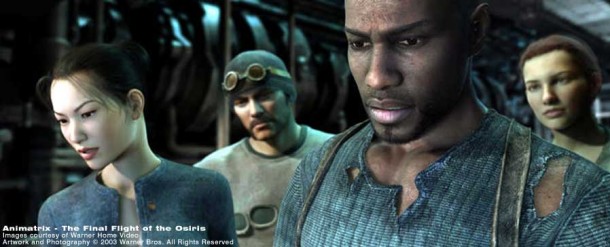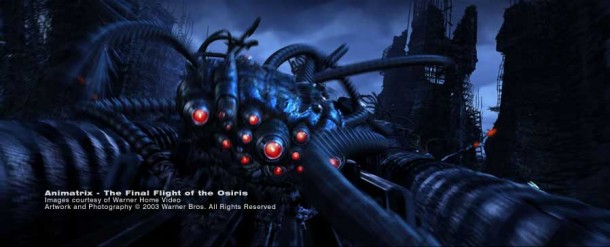The Final Flight of the Osiris
From Final Fantasy to Final Flight, we bring you Andy Jones
Final Fantasy: The Spirits Within was the first of its kind.
Unlike other computer animated films such as Toy Story or Shrek, never before had anyone attempted to create a feature film that looked almost real. It was a bold experiment.
However, due to the lack of financial success, this alone may have sent this new style of digital cinema underground, at least, for a while.
But the geniuses behind this first experiment also were given the chance to work on a second project. Building on the experience they gained working on Final Fantasy, they pushed the technology and their knowledge even further to create something more advanced.
The result is a short film called “The Final Flight of the Osiris”, based on “The Matrix” franchise and supervised by the Wachowski Brothers, creators of the Matrix and Matrix Reloaded and part of a series of 9 short film created by 7 different directors. So far, both the critics and the public are raving.
It seems this short film alone might bring this new style back in the limelight. Introducing Andy Jones, Director of “The Final Flight of the Osiris”. It seems they will be talking about this for years to come.
CGC: Could you begin by telling us about your professional background?
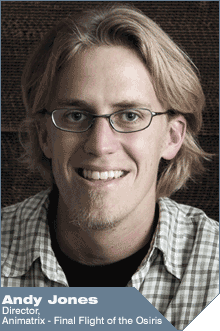 AJ: I went to UCLA where I was a design major. During my freshmen year, I was inspired to get into this field after viewing John Lasseter’s short “Luxo Jr.”. I started to take classes in both traditional animation and computer animation. I created a short film that took second place at the Siggraph student animation competition and then was hired by Digital Domain. I worked as a lead animator for several commercial projects before supervising the animation for 30 shots of Titanic’s “sinking sequence”. Shortly after Titanic, I left DD to animation supervise Roland Emerich’s “Godzilla” at Centropolis Effects. After Godzilla I was hired by Square USA to Animation Direct for “Final Fantasy:TSW”. I was just finishing up on FF when the Wachowski’s approached us to do “Osiris”
AJ: I went to UCLA where I was a design major. During my freshmen year, I was inspired to get into this field after viewing John Lasseter’s short “Luxo Jr.”. I started to take classes in both traditional animation and computer animation. I created a short film that took second place at the Siggraph student animation competition and then was hired by Digital Domain. I worked as a lead animator for several commercial projects before supervising the animation for 30 shots of Titanic’s “sinking sequence”. Shortly after Titanic, I left DD to animation supervise Roland Emerich’s “Godzilla” at Centropolis Effects. After Godzilla I was hired by Square USA to Animation Direct for “Final Fantasy:TSW”. I was just finishing up on FF when the Wachowski’s approached us to do “Osiris”
CGC: Before working on the Final Flight of the Osiris, you directed Final Fantasy: The Spirits Within. Beyond the length and the scope of the project, how would you compare the two projects technologically speaking?
AJ: My job was a bit different on the two projects; on FF I was animation director and then on “Osiris” I was the director. I had a lot more control of the story telling and the action and the final look of the shots. I think we pushed the technology a bit further than FF ? in regards to the facial animation, skin deformation, and the skin texture. We had developed so much on FF In terms of tools and technology that it was easy to just add to our existing pipeline with more details to get a little closer to realism.
CGC: Tell us more about the advances you were able to achieve in creating realistic human skin?
AJ: Our lead character artist Steven Giesler was primarily responsible for pushing these characters as realistic as we could get them. He spent painstaking hours painting every mole, wrinkle and pore of the skin as well as adjusting the facial models so that they felt balanced. When you combine his artistic talent with the technical achievements written in to our skin shader, you get pretty amazing results.
CGC: Skin and muscle deformation techniques have been pushed even further since Final Fantasy, what can you tell us about this?
AJ: The skin and Muscle techniques were specifically created for “Osiris” by Ben Rush. He pioneered the Pose base system that we developed to pull off this opening sequence. This system allowed the modelers to sculpt shapes at various poses to give the illusion of muscle underneath the skin.
CGC: From character design, modeling, texturing, rigging and rendering, give us a description of the character creation pipeline at Square?
AJ: The characters were first designed in photoshop as artist renders. They were then modeled in 3D. Every face we created had the same amount of polys to simplify the UV mapping and facilitate the transfer of animation control from one character to the other. The texturing of the faces was done in conjunction with the modeling because we found that to correctly balance the faces, you have to be tweaking the model and the texture simultaneously. The bodies were modeled separate and later the proportions would be adjusted to balance with the completed faces. The rigging was a process as well. We had two master rigs (one female and one male) that could be adjusted to fit all characters. Our primary deformation technique was to use a low res smooth bound weighted cage that would drive the hi-rez geometry through a proprietary tool similar to the “wrap” tool in Maya. We could also use the pose base system to sculpt the cage into the correct shapes for various poses.
CGC: What are the commercial and in-house tools you use?
AJ: We used a Motion Analysis System to do our motion capture. We had some in-house tools built to make the motion capture “animator friendly”. In other words, we treated the motion capture as another tool for the animators to access. They could use it for different sections and turn it off when they needed to key something. Our R&D department also wrote an amazing cloth simulation tool. We were able to get great results whether we wanted a silky look or a stiff leather feel.
CGC: What rendering technology did you use?
AJ: We used Renderman to render everything. We used MtoR as the front end for our lighting department to light the shots. There were a slew of tools developed to assist the lighting department.
CGC: You made extensive use of GI in this film. How did you manage to bring down rendering times to something reasonable?
AJ: Actually, it is faked GI. I wanted a GI feel to the entire opening scene as well as the Matrix city scene. Greg Lev, our lead lighting artist, came up with a solution of creating a dome light around each character made up of 180 lights. Instead of generating 180 shadow ribs Kevin Bjorke wrote a tool that would use one shadow rib and just offset the viewpoint to each separate light and render the next shadow map. This dramatically decreased the render times.
CGC: On a more philosophical level, Final Fantasy caused quite a controversy in the Hollywood with its digital actors. Some flesh and blood actors even felt threatened by this. How do you view the situation?
AJ: I think it is silly. The closer we get to replicating humans, the more we will need an actor to drive the performance. Actors bring spontaneity to a subtle performance where as animators use exaggeration to “over act” making up for the lack of spontaneity. This works great with stylized cartoon characters; but the more real they become the more you have to use motion capture or roto animation driven by an actor to pull off a performance.
CGC: Despite the spectacular work done by the digital artists at Square, Final Fantasy didn’t fare too well at the box office. And yet, The Final Flight of the Osiris seems to be gathering rave reviews and great public reaction. Do you think we’ll see more films that look like this in the near future?
AJ: Unfortunately, I think FF’s failure slowed down the chances of more projects along these lines. We learned a lot from making FF and used that knowledge to make “Osiris”. It is a shame that just when it seems that we are starting to get it right, we had to stop. This process of film making is down but not out. I would love to make more films like “Osiris”.
CGC: What is your proudest achievement on this film?
AJ: The overall look and feel of the piece. The immersion level one feels when watching it. I think we were able to achieve a greater connection with our audience than we did with FF.
CGC: Looking back now, if you were given the opportunity to do a full-featured film like this one, would you do it?
AJ: Yes, definitely. With each project, we learned a tremendous amount. Given all of that experience, I really think we could make a very compelling feature film with this hyper-real style.
CGC: What’s next in line for you?
AJ: I am currently animation directing for Digital Domain where we have just landed a significant portion of CG animation for a very big Sci-Fi movie slated to release summer of 2004.
Related Sites:
The Matrix home-page
The Animatrix
Watch the Animatrix trailer
Major Editorial Contribution by: Xen Wildman

